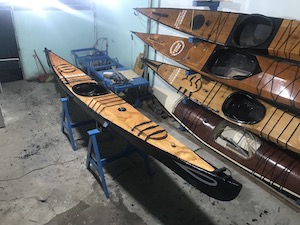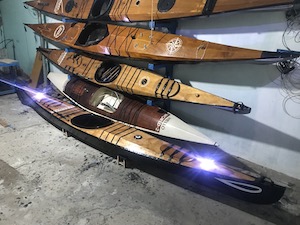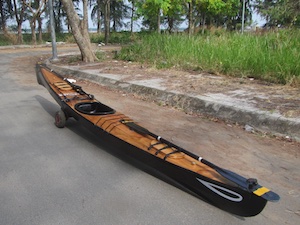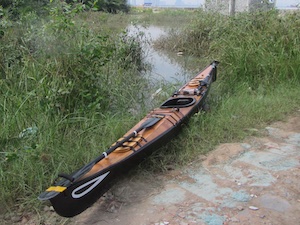Made 2 short paddling rounds at night (due to local water conditions, about 5 ~ 10km each) and 2 hour of rolling to test the kayak, to see if everything works as expected. They’re leak – tests (much like smoke – test in electronic and software engineering). And indeed, found and fixed a minor leak in the aft compartment (at the joint right after the cockpit). The hatches are completely water – tight, there’s nothing to worry about. The tests only assure me on the “static” side of the boat: it tracks too straight (a bit hard to turn in tight corner, but that’s a desired behaviour) and the speed seems to be good too (a claim to be backed by GPS numbers later on). About “static” and “dynamic”…
Much like sailboat (but perhaps to a lesser extent), there’re much differences between “static” and “dynamic” aspects. There’re boats that seem to fair well on stable water, but behave badly in weather, and there’re boats that don’t feel very stable on calm water, but excel themselves in turbulences. So actually, it’s the dynamic side that’s more important, but that would require long testings to really know. For now, I would just try to detect and fix small issues. First is to make some small changes to the rudder’s pedals, to make the foot – work a bit more comfortable… Then test running the light – bulbs for many hours to see if they’re durable enough, and to measure the battery usage!
Detected a faulty (low quality) 12V DC connector which builds up too much heat if used for a long time, to the point of plastic melting down. I had to replace them with better ones. The new battery box now has 2 blocks, 12 cells of 18650 batteries in total, and 2 additional, reserved slots to install 2 more blocks later. So the maximum capacity is about 20 Ah at 12.6V, each block is about 5 Ah. I guess the actual, usable number is much less, not that advertised, ideal – conditions number. I discovered an important thing: although the voltage indicator (8-segments display) consumes very little power (less than 30 mA), letting it always ON would drain the battery pretty fast (about 0.1V per day)…
Maybe there’s some hidden, internal consumption by the BMS – battery management system). So I’ve added a switch and turn it OFF when not in use, and the battery box would last for weeks (not just days), before needing a recharge. A small chip (the size of your thumb) will be in charge of downgrading the 12V current into 5V and serve it through a USB port, it charges my iPhone just well, and pretty much every devices is using USB – charging nowadays. At this point, the boat is pretty much heavy, already over 33 kg, but that includes everything: rudder and pedals, the battery box, the compass, light bulbs, the bilge pump, etc… Would update more on boat trialling in the coming weeks…




